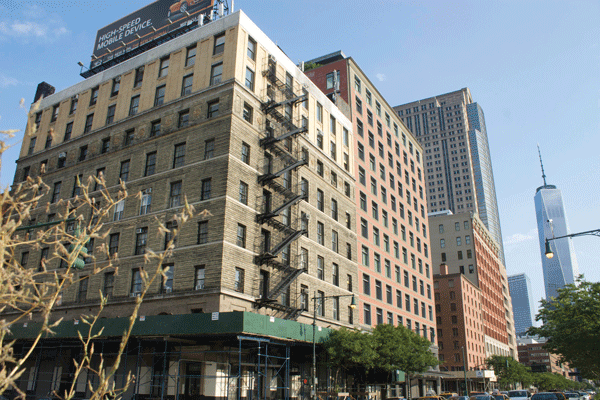
BY ZACH WILLIAMS | Residents of 67 Vestry St. have not given up on efforts to preserve their homes in an 117-year-old former warehouse in Tribeca.
Although efforts to landmark the building fell short in the spring, a handful of options remain for the tenants, including challenging the permit process and working through local elected representatives.
Owner Aby Rosen received approval from the city Department of Buildings on July 22 for an 11-story building, which would replace the current structure, should demolition permits eventually be acquired. However, no such application has been received by D.O.B., according to department records.
In the meantime, residents are examining their legal options, including possible grounds for appealing the approved building design with the help of Borough President Gale Brewer. There is also talk about expanding the Tribeca North Historic District to accommodate 67 Vestry St. — which lies just outside the current district boundaries — with the incoming Landmarks Preservation Commission Chairperson Meenakshi Srinivan, according to Jacqueline Miro, a 16-year resident of the building. She added that a date for such a meeting has yet to be set due to scheduling conflicts.
“It’s not an easy building to pull down,” she said on Aug. 10. “It’s got history. It’s got force and it’s got unmovable tenants.”
A previous effort to have the city Landmarks Commission re-examine its prior decision was not successful. Robert Tierney, outgoing chairperson of the commission, reiterated the reasoning behind the board’s prior decision not to landmark the building, in a June 1 letter to Community Board 1.
“Though the property’s history as the first large, purpose-built warehouse of the A&P Company and as an example of the work of architect Frank Dinkelberg does not altogether lack merit, there are numerous more intact buildings within the Tribeca historic district that encapsulate this area’s warehouse history,” Tierney wrote.
Alterations made in 1910 added two floors, diluting the historical value of the building, Tierney added.
The nine-story building, though, is one of the few remaining warehouses along West St., said Miro, an architect. Its role in the advent of reinforced concrete within the American architectural canon further distinguishes it from other former warehouses which utilized more primitive materials, according to Miro.
More recently, the building housed some of the artists, including Andy Warhol, who would transform Tribeca during the ’70s and ’80s from a grimy industrial area into a ritzy residential neighborhood. Now the neighborhood ranks among the most affluent in New York City — making it prime territory for developers.
According to the plans approved by D.O.B., the new building would be 134 feet high and have 42 residential units.
“I love old Tribeca. There’s not much left,” said Orshi Drozdik, an artist and longtime resident of the building.
Fifteen out of 23 units within the building remain occupied, according to Miro. However, the remaining residents fall into two categories, she acknowledged: longtime residents inclined to fight displacement, and a “less enamored” group of residents who are more open to negotiation, or who are just sick of fighting.
Among them was one resident who said he received a buyout offer from the landlord, though “not in writing.”
Only the one resident said he has received an offer from the landlord, among five residents interviewed for this article.
Rosen representatives did not respond to requests for comment.
“I just want to enjoy it as long as I can live here,” Drozdik said, “and hope that [Rosen] cannot demolish it.”

















